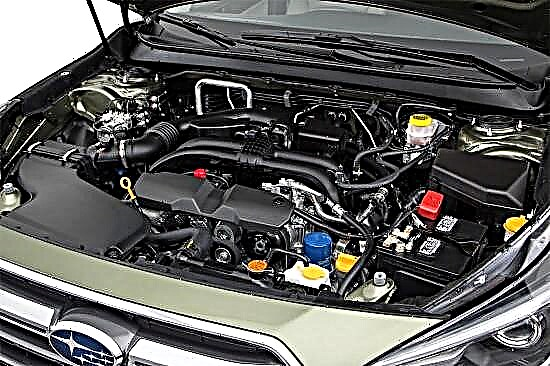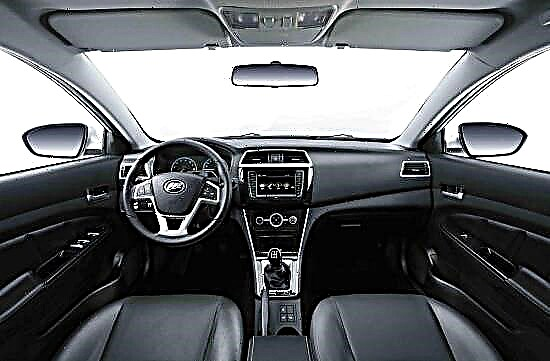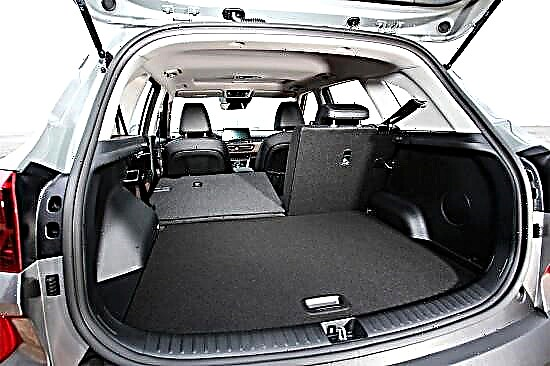Ratings of cars and auto products
Reviews, comparisons & tips for motorists
The whole world has long known how to impress others, costing little blood - for money they sew labels of famous brands for Chinese-made clothing, remove the designation of the engine volume and equipment from basic cars, and also buy goods that only look expensive and solid ... Are the crossovers the most famous of which are the Honda CR-V and Toyota RAV4? After all, cars are equipped with powerful engines with a large displacement, and also have a far from low cost - however, despite their brutal appearance, they are not positioned by manufacturers as off-road vehicles. What they are - an imitation of high cross-country vehicles or simply passenger cars improved in the direction of greater practicality, the comparison of RAV4 against SRV will show.
Modern powerful crossovers - Honda CR-V and Toyota RAV4
In different road conditions
Dirty competition
If you look at the outside of the Toyota RAV4, you would think that we are facing a slightly smaller version of the Land Cruiser - the similarity is especially noticeable when viewed in profile. In addition, a ground clearance of almost 200 mm and a center differential lock button instill confidence that the RAV4 can overcome the most serious obstacles that modern crossovers can handle. However, in practice, everything turns out to be much more complicated - Toyota RAV4 easily enters into a deep puddle on a dirt road, reaches the middle and starts to get stuck. The natural reaction of a driver with experience in off-road driving is to smoothly but actively increase the fuel supply to prevent the car from stopping and finally getting stuck. For Toyota, such an action would be a big mistake - the electronics, which do not have an "off-road" algorithm of operation, detects slipping and concludes that the car is on an icy road - the result is a sharp decrease in the RAV4 engine speed, as a result of which the car stalls.
It's time to call the tractor driver - however, even after such an embarrassment, I want to give Toyota RAV4 another chance to justify itself and protect the honor of Japanese crossovers. The vehicle will now drive over rough terrain, teeming with deep ditches and steep hillsides. And again we have to stop the test - The low-hanging bumpers of the RAV4 begin to hit the ground threateningly, which indicates a large material cost in case of continuing to move in this mode. The third and last chance relates to checking the Toyota RAV4 center differential lock - indeed, on a soggy primer, the car starts to move much more confidently. But all the enthusiasm received by the RAV4 as a result of pressing the button is enough for 10-15 minutes, after which the electronics turns off the overheated clutch, and again you have to call the tractor driver who is already completely tired of side work.
If we talk about who has a more advanced all-wheel drive system - SRV or RAV4, then the disputes will be absolutely useless, because both vehicles have a transmission based on the use of an electronically controlled multi-plate clutch. However, how can we not recall the recent scandal when the technical specialists of the Swedish automobile publication discovered that the four-wheel drive on the Honda CR-V in half the cases ... simply does not work! Let's check if this is so - the Honda CR-V plunges briskly enough into a puddle, and stops at about the same place as the Toyota RAV4. At the same time, the problem cannot be attributed to the intervention of the stabilization system - in a high-speed Honda engine, it works much later. The reason is a completely different drawback - the ground clearance of the Honda CR-V is only 187 mm, and some elements of the chassis are located slightly lower, which leads to a quick and irrevocable crossover bogging in thick mud.
Despite the fact that a strip of unpainted plastic runs along the perimeter of the lower part of the Honda CR-V body, imitating off-road protection, it really does not carry any functional load - the plastic body kit drops very low and significantly worsens the angles of entry and exit, even in comparison with such a crossover as Toyota RAV4. In addition, there is no center differential lock on the CR-V at all. What can I say - after 5 minutes of active movement on the dirt road, heavily moistened by yesterday's rain, Honda stops as a result of overheating of the clutch. It seems that this problem is a typical "disease" of modern crossovers, but the Honda CR-V gives up before the rest. The final verdict is only asphalt and only good road conditions, and the maximum feat for the CR-V should be driving out of a snowy yard.
We return to the asphalt
Now it's worth checking how the cars behave in their native environment, that is, on a good road with high-quality coverage and all the necessary amenities, such as markings and fencing applied on time. Toyota RAV4 is perceived as a real "king of the road" - the high seating position allows looking into the windows not only of real SUVs, but also of fixed-route taxis. At the same time, no discomfort associated with the increased center of gravity and the large mass of the car is felt at all in the city and on suburban roads. On the asphalt broken by long-term operation, the Toyota RAV4 behaves quite ambiguously - the positive is that the car confidently goes through any irregularities, without notifying about it with the booming blows of passengers, and among the minuses one can name an extremely unpleasant swing of the steering wheel.
Test drive of Toyota RAV4 car:
If you choose - Honda SRV or RAV4, then Toyota will be preferable for relatively low speeds, in which it shows an enviable smoothness and softness. But the increase in speed is displayed on the RAV4 not in the most beneficial way, as it causes noticeable rolls and even small drifts, which are manifested in especially sharp turns. Sure, Toyota's stabilization system does not allow getting into big trouble, but it works very unpleasantly, forcing it to slow down as a result of an instant drop in engine speed.
But the Honda CR-V is a real racing car - at least, this is evidenced by the stiff suspension, which makes passengers jump slightly when hitting another deep pothole in the road. On the track, these settings are taken for granted, but in the city, the Honda CR-V sometimes even annoys the driver, forcing them to slow down before every junction of the roadway and every pothole. However the suspension is quite energy-intensive and in any case does not allow the bottom to touch the speed bumps, although sometimes it seems to the passengers inside that this was the reason for the disturbance of their peace.
Test drive of the Honda CR-V car:
On the other hand, the relatively short-stroke struts perform excellently on winding roads, where the Honda CR-V is unmatched among crossovers. The rolls, which somewhat annoy Toyota RAV4 owners, are completely absent here, which pleases fans of an active driving style. It seems as if the car itself is forcing the driver to step on the gas pedal more and more, trying to catch the moment when the incredibly sensitive steering of the Honda CR-V finally refuses to obey the person, and the car begins to slide, exceeding its limits. However, in practice, only a completely desperate person or a racing pilot will be able to do this with the Honda CR-V.Honda also has its own stabilization system, but it works much later, giving the driver the opportunity to fully experience the adrenaline rush into the bloodstream.
Movers
Motors
In the USA, the Toyota RAV4 can be equipped with a powerful V6 engine, which makes it a real sports car, allowing you to confidently exceed the 200 km / h threshold on an unlimited highway that stretches to the horizon. But for our country and most other regions of the world, the reality turns out to be much more prosaic - the top-end Toyota engine with a volume of 2.5 liters and a capacity of 180 horsepower. Such a power unit is ideally suited to the large RAV4 crossover - most of the traction is available already at low revs, and with an increase in speed, the car still has a significant dynamic margin, allowing it to actively accelerate even on country roads. If the car had serious all-wheel drive, the Toyota RAV4 engine would allow it to make sorties on very serious off-road - the reaction to pressing the gas pedal is almost instantaneous, which makes it possible to actively climb slopes without risking stopping halfway due to lack of traction. However, the appetite of the Toyota power unit is rather big - in the city you can safely count on the consumption of 10–12 liters of gasoline per 100 km, and on the highway the figure decreases only to 7–8 liters.
Like Toyota RAV4, Honda SRV is equipped with a large engine - however, its drive unit is taken almost unchanged from the Accord passenger model with all the ensuing consequences. The power rating of the Honda CR-V is slightly higher than that of the Toyota RAV4, but to use it, you have to constantly maintain high revs, pushing the gas pedal by more than half. As a result, it is impossible to move calmly on the CR-V - the only driving mode in which you can get rid of serious jerks is driving on a flat country road, when the car's potential is only partially used. In addition, it is even good that the Honda CR-V is not equipped with good off-road equipment, because it would be extremely inconvenient to control such a power unit on rough terrain. Losing in the dynamics of acceleration to the Toyota crossover, the Honda CR-V also consumes more fuel - the average in the city is 12 liters, and if you want to show everything that a high-speed engine is capable of, the figure reaches 15-16 liters per 100 km.
Transmissions
What lies behind Toyota's leadership - is it really possible to fine-tune the engine so that it is efficient in all driving conditions? Of course you can - but much of the success of the RAV4 is due to the use of a modern six-speed automatic transmission. Like the Honda CR-V, the Toyota RAV4 is equipped with a traditional hydromechanical unit - the company's engineers decided to make an exception for a large crossover and did not use the now fashionable CVTs or robotic gearboxes. Although it sometimes seems as if the RAV4 unit is really devoid of any stages and smoothly changes the gear ratio in accordance with the change in driving mode - the shifts are so imperceptible. As a result, the Toyota RAV4 is not only faster, but also more comfortable than most of its rivals in the crossover class.
If at Toyota the "automatic" is one of the most important components of success, then at the Honda CR-V it is the "root of evil". Of course, this five-speed unit is constantly undergoing minor modifications and changes in settings, but its design has become outdated for a long time, which forces us to put up with long switching delays, as well as an inadequate choice of the current gear ratio. Largely because of the powertrain, the Honda CR-V loses out to the RAV4 in comparison areas such as efficiency and dynamics. Perhaps the CR-V with a manual transmission will turn out to be a little more balanced, but in our country such cars are not in great demand.
| Car model: | Toyota RAV4 | Honda cr-v |
| Producing country: | Japan | Japan |
| Body type: | Crossover | Crossover |
| Number of places: | 5 | 5 |
| Number of doors: | 5 | 5 |
| Engine displacement, cubic meters cm: | 2494 | 2354 |
| Power, hp with. / about. min .: | 180/6000 | 190/7000 |
| Maximum speed, km / h: | 180 | 184 |
| Acceleration to 100 km / h, s: | 9,4 | 10,7 |
| Type of drive: | Full | Full |
| Checkpoint: | 6 automatic transmission | 5 automatic transmission |
| Fuel type: | Gasoline AI-95 | Gasoline AI-95 |
| Consumption per 100 km: | In the city 11.4 / Outside the city 8.5 | In the city 11.9 / Outside the city 8.4 |
| Length, mm: | 4570 | 4571 |
| Width, mm: | 1845 | 1820 |
| Height, mm: | 1660 | 1685 |
| Clearance, mm: | 197 | 187 |
| Tire size: | 225/65 R17 | 225/60 R18 |
| Curb weight, kg: | 1610 | 1608 |
| Full weight, kg: | 2080 | 2055 |
| Fuel tank volume: | 60 | 58 |
Practicality
Design controversy aside, let's move directly to the consideration of vehicle capacity, which is a very important characteristic for crossovers. In Russia, Toyota RAV4s are sold only in a complete set with a full-size spare wheel - this limits the volume of the luggage compartment with the rear sofa folded out to 500 liters. However, if you do not use the rear Toyota seats, then the capacity can be increased to a quite decent 1.6 cubic meters. Passengers do not complain about the cramped space - even people with a fairly large build feel free in the RAV4, which is due to the large margin of space in width, height and distance to the front seats.
Arranging a comparison of the RAV4 against the Honda SRV, at first you think that the last crossover will win, since in its normal state its trunk has a volume of 580 liters. However, if the seats are folded down, the figure rises to ... 1.1 cubic meters! The small increase was due to the fact that Honda was the last thing to think about trucking - the CR-V's priority was dynamics. This is evidenced by the small rear sofa of the Honda CR-V, on which three people can fit only on condition that they are ready to endure the tightness and knees of the front seats.
Asphalt cruisers
If the name Land Cruiser is translated as "Land Cruiser", then these crossovers would like to be called asphalt cruisers. The large dimensions of the Toyota RAV4 and Honda CR-V make both cars practical and roomy, but do not give them the right to be called SUVs at all. This is especially true of the Honda CR-V, the element of which is fast movement on international highways. Toyota RAV4 is in many ways more pleasant to drive, but do not forget about the presence of certain nuances associated with the large mass and moderately soft chassis.











